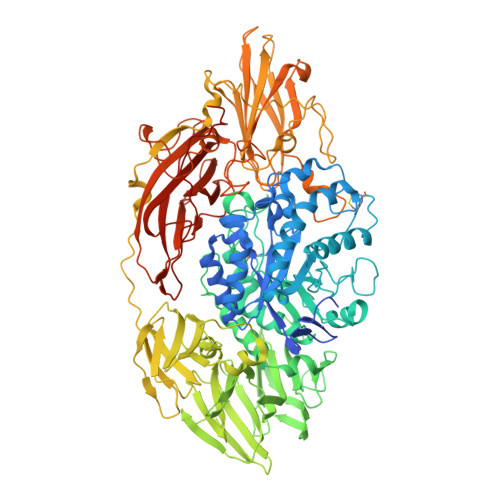Structural features of Aspergillus niger beta-galactosidase define its activity against glycoside linkages.
Rico-Diaz, A., Ramirez-Escudero, M., Vizoso-Vazquez, A., Cerdan, M.E., Becerra, M., Sanz-Aparicio, J.(2017) FEBS J 284: 1815-1829
- PubMed: 28391618
- DOI: https://doi.org/10.1111/febs.14083
- Primary Citation of Related Structures:
5IFP, 5IFT, 5IHR, 5JUV, 5MGC, 5MGD - PubMed Abstract:
β-Galactosidases are biotechnologically interesting enzymes that catalyze the hydrolysis or transgalactosylation of β-galactosides. Among them, the Aspergillus niger β-galactosidase (AnβGal) belongs to the glycoside hydrolase family 35 (GH35) and is widely used in the industry due to its high hydrolytic activity which is used to degrade lactose. We present here its three-dimensional structure in complex with different oligosaccharides, to illustrate the structural determinants of the broad specificity of the enzyme against different glycoside linkages. Remarkably, the residues Phe264, Tyr304, and Trp806 make a dynamic hydrophobic platform that accommodates the sugar at subsite +1 suggesting a main role on the recognition of structurally different substrates. Moreover, complexes with the trisaccharides show two potential subsites +2 depending on the substrate type. This feature and the peculiar shape of its wide cavity suggest that AnβGal might accommodate branched substrates from the complex net of polysaccharides composing the plant material in its natural environment. Relevant residues were selected and mutagenesis analyses were performed to evaluate their role in the catalytic performance and the hydrolase/transferase ratio of AnβGal. Thus, we generated mutants with improved transgalactosylation activity. In particular, the variant Y304F/Y355H/N357G/W806F displays a higher level of galacto-oligosaccharides production than the Aspergillus oryzae β-galactosidase, which is the preferred enzyme in the industry owing to its high transferase activity. Our results provide new knowledge on the determinants modulating specificity and the catalytic performance of fungal GH35 β-galactosidases. In turn, this fundamental background gives novel tools for the future improvement of these enzymes, which represent an interesting target for rational design. Structural data are available in PDB database under the accession numbers 5IFP (native form), 5IHR (in complex with 6GalGlu), 5IFT (in complex with 3GalGlu), 5JUV (in complex with 6GalGal), 5MGC (in complex with 4GalLac), and 5MGD (in complex with 6GalLac).
Organizational Affiliation:
Grupo EXPRELA, Centro de Investigacións Científicas Avanzadas (CICA), Departamento de Bioloxía, Facultade de Ciencias, Universidade da Coruña, Spain.



















